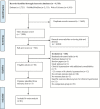Impact of Chronic Hypertension and Antihypertensive Treatment on Adverse Perinatal Outcomes: Systematic Review and Meta-Analysis
- PMID: 33870708
- PMCID: PMC8200761
- DOI: 10.1161/JAHA.120.018494
Impact of Chronic Hypertension and Antihypertensive Treatment on Adverse Perinatal Outcomes: Systematic Review and Meta-Analysis
Abstract
Background Maternal chronic hypertension is associated with adverse pregnancy outcomes. Previous studies examined the association between either chronic hypertension or antihypertensive treatment and adverse pregnancy outcomes. We aimed to synthesize the evidence on the effect of chronic hypertension/antihypertensive treatment on adverse pregnancy outcomes. Methods and Results Medline/PubMed, EMBASE, and Web of Science were searched; we included observational studies and assessed the effect of race/ethnicity, where possible, following a registered protocol (CRD42019120088). Random-effects meta-analyses were used. A total of 81 studies were identified on chronic hypertension, and a total of 16 studies were identified on antihypertensive treatment. Chronic hypertension was associated with higher odds of preeclampsia (adjusted odd ratio [aOR], 5.43; 95% CI, 3.85-7.65); cesarean section (aOR, 1.87; 95% CI, 1.6-2.16); maternal mortality (aOR, 4.80; 95% CI, 3.04-7.58); preterm birth (aOR, 2.23; 95% CI, 1.96-2.53); stillbirth (aOR, 2.32; 95% CI, 2.22-2.42); and small for gestational age (SGA) (aOR, 1.96; 95% CI, 1.6-2.40). Subgroup analyses indicated that maternal race/ethnicity does not influence the observed associations. Women with chronic hypertension on antihypertensive treatment (versus untreated) had higher odds of SGA (aOR, 1.86; 95% CI, 1.38-2.50). Conclusions Chronic hypertension is associated with adverse pregnancy outcomes, and these associations appear to be independent of maternal race/ethnicity. In women with chronic hypertension, those on treatment had a higher risk of SGA, although the number of studies was limited. This could result from a direct effect of the treatment or because severe hypertension during pregnancy is a risk factor for SGA and women with severe hypertension are more likely to be treated. The effect of antihypertensive treatment on SGA needs to be further tested with large randomized controlled trials.
Keywords: antihypertensive; chronic hypertension; fetal outcome; meta‐analysis; neonatal outcome; pregnancy; systematic review.
Conflict of interest statement
None.
Figures




Similar articles
-
Maternal Hypertension, Antihypertensive Medication Use, and Small for Gestational Age Births in the National Birth Defects Prevention Study, 1997-2011.Matern Child Health J. 2018 Feb;22(2):237-246. doi: 10.1007/s10995-017-2395-8. Matern Child Health J. 2018. PMID: 29124624 Free PMC article.
-
Role of Antihypertensive Treatment and Blood Pressure Control in the Occurrence of Adverse Pregnancy Outcomes: a Population-Based Study of Linked Electronic Health Records.Hypertension. 2022 Jul;79(7):1548-1558. doi: 10.1161/HYPERTENSIONAHA.122.18920. Epub 2022 May 3. Hypertension. 2022. PMID: 35502665
-
MOS HIP: McMaster outcome study of hypertension in pregnancy.Early Hum Dev. 2001 Sep;64(2):129-43. doi: 10.1016/s0378-3782(01)00181-5. Early Hum Dev. 2001. PMID: 11440825
-
Maternal and Perinatal Outcomes of White Coat Hypertension During Pregnancy: A Systematic Review and Meta-Analysis.Hypertension. 2020 Jul;76(1):157-166. doi: 10.1161/HYPERTENSIONAHA.119.14627. Epub 2020 May 26. Hypertension. 2020. PMID: 32450741
-
Calcium supplementation commencing before or early in pregnancy, for preventing hypertensive disorders of pregnancy.Cochrane Database Syst Rev. 2019 Sep 16;9(9):CD011192. doi: 10.1002/14651858.CD011192.pub3. Cochrane Database Syst Rev. 2019. PMID: 31523806 Free PMC article.
Cited by
-
Does geographical location impact the efficacy of oral antihypertensive therapy in pregnancy?J Turk Ger Gynecol Assoc. 2025 Jun 10;26(2):142-153. doi: 10.4274/jtgga.galenos.2024.2024-1-8. J Turk Ger Gynecol Assoc. 2025. PMID: 40495564 Free PMC article.
-
Qualineo Strategy Indicators Associated with Neonatal Death: A Cross-Sectional Study.Int J Environ Res Public Health. 2024 Aug 19;21(8):1096. doi: 10.3390/ijerph21081096. Int J Environ Res Public Health. 2024. PMID: 39200704 Free PMC article.
-
Effect of daily physical activity on ambulatory blood pressure in pregnant women with chronic hypertension: A prospective cohort study protocol.PLoS One. 2024 Jan 10;19(1):e0296023. doi: 10.1371/journal.pone.0296023. eCollection 2024. PLoS One. 2024. PMID: 38198464 Free PMC article.
-
Diagnostic properties of differing BP thresholds for adverse pregnancy outcomes in standard-risk nulliparous women: A secondary analysis of SCOPE cohort data.PLoS Med. 2025 Jan 22;22(1):e1004471. doi: 10.1371/journal.pmed.1004471. eCollection 2025 Jan. PLoS Med. 2025. PMID: 39841727 Free PMC article.
-
American College of Cardiology and American Heart Association blood pressure categories-a systematic review of the relationship with adverse pregnancy outcomes in the first half of pregnancy.Am J Obstet Gynecol. 2023 Apr;228(4):418-429.e34. doi: 10.1016/j.ajog.2022.10.004. Epub 2022 Oct 12. Am J Obstet Gynecol. 2023. PMID: 36241079 Free PMC article.
References
-
- Brown MA, Magee LA, Kenny LC, Karumanchi SA, McCarthy FP, Saito S, Hall DR, Warren CE, Adoyi G, Ishaku S. Hypertensive disorders of pregnancy: ISSHP classification, diagnosis, and management recommendations for international practice. Hypertension. 2018;72:24–43. DOI: 10.1161/HYPERTENSIONAHA.117.10803. - DOI - PubMed
Publication types
MeSH terms
Substances
LinkOut - more resources
Full Text Sources
Medical

